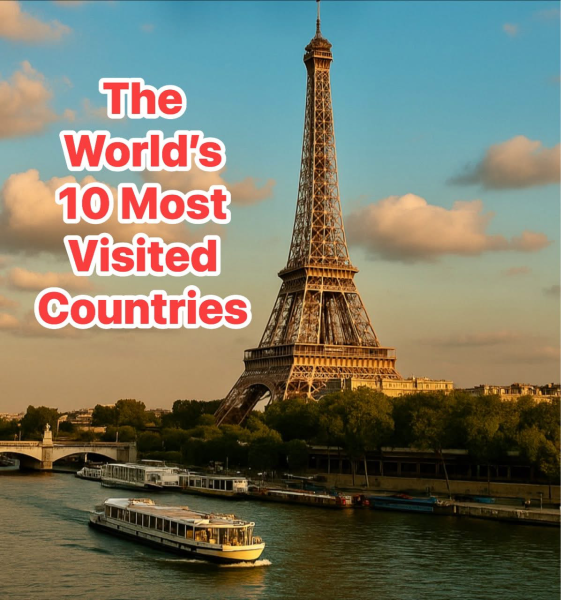BANGKOK, 26 November 2025: International travel continued its remarkable rebound last year, with 1.45 billion cross-border arrivals recorded globally, according to the UN Tourism (UNWTO).
In preparing this review of the world’s 10 most visited countries, I have relied on the latest official 2024 international arrival figures, not older or pre-pandemic Google summaries that still circulate online. I have also highlighted how each country grew from 2023 to 2024, giving a true sense of momentum.

As someone who has worked in tourism for more than 40 years, these rankings reveal changing traveller behaviour, shifting airline routes, new visa policies, and evolving global tastes. They also tell a powerful story about how destinations are positioning themselves in an increasingly competitive world.
How tourism GDP is measured
A tourist is an international visitor who travels outside their usual environment and stays at least one night for leisure, business, or other purposes. Tourism’s contribution to GDP combines direct spending on hotels, restaurants, attractions and local transport with broader indirect and induced impacts through supply chains, investment and jobs. The percentages listed for each country reflect WTTC’s full Travel and Tourism contribution, which is the globally accepted standard.
▫️1. France
2024 arrivals: 102 million, up 2% on 2023
France remains the world’s most visited nation. Its appeal is astonishingly broad. Visitors are drawn to Paris and its iconic culture, but equally to regions such as Provence, Brittany and the Loire Valley. French gastronomy, wine tourism, and shopping continue to set the global benchmark for lifestyle travel. As I review these figures each year, France always stands out for combining mass appeal with refined, high-value tourism. Tourism share of GDP: 9%*.
▫️2. Spain
2024 arrivals: 93.8 million, up 10%
Spain’s growth last year was one of the strongest in Europe. The blend of Mediterranean beaches, Barcelona and Madrid’s cultural energy, and the islands’ exceptional climate offers year-round appeal. Food, festivals and modern tourism infrastructure keep Spain firmly in second place. Tourism share of GDP: 15 to 16%.
▫️3. USA
2024 arrivals: 72.4 million, up 9%
The US attracts visitors for its wide variety. Iconic cities, national parks, business travel, entertainment, education and major events all contribute. Orlando, New York and Las Vegas remain global hubs of demand. Domestic travel is vast and continues to reinforce the sector’s size. Tourism share of GDP: just under 10%.

▫️4. Türkiye
2024 arrivals: 60.6 million, up 10%
Türkiye has surged in popularity, driven by Istanbul’s cultural magnetism, the value-for-money coastal resorts of Antalya and Bodrum and improved connectivity. Currency dynamics made Türkiye exceptionally competitive in 2024. Tourism share of GDP: 12%*.
▫️5. Italy
2024 arrivals: 57.8 million, up 3%
Italy’s tourism strength is built on history, art, cities and food. Rome, Venice and Florence remain the core draws, but Italy’s lifestyle tourism from lakes to islands helps spread visitors more evenly. Tourism share of GDP: 10 to 11%.
▫️6. Mexico
2024 arrivals: 45 million, up 6 per cent
Mexican tourism is driven by strong US and Canadian demand, excellent air connectivity and globally recognised sun-and-sand destinations. Its cultural depth remains one of its greatest assets. Tourism share of GDP: 15%*.
▫️7. UK
2024 arrivals: 41.8 million, up 12%
The UK had one of the highest growth rates in the top ten. London continues to anchor the country’s appeal, offering free museums, theatre, royal heritage, and world-class dining. Beyond the capital, tourism is strengthened by Edinburgh, the Highlands, the Lake District, York, Bath, the Welsh national parks and Northern Ireland’s coastal landscapes.
The UK punches far above its size thanks to global soft power, Premier League football, festivals, heritage, international education and major events. This diversity of appeal is what keeps the UK consistently within the top tier. Tourism share of GDP: 10%*.

▫️8. Germany
2024 arrivals: 37.5 million, up 8%
Germany offers a powerful combination of leisure and business travel. Christmas markets, cultural cities, and scenic routes give it seasonal variety, while trade fairs and exhibitions underpin its strength in business tourism. Tourism share of GDP: 11 to 12%.
▫️9. Japan
2024 arrivals: 36.9 million, up 47%
Japan’s recovery has been exceptional. A weak yen, improved air access, and high interest from global travellers fuelled a record-breaking return. Cherry blossom, food culture, safety and efficient transport all reinforce Japan’s international brand. Tourism share of GDP: 7 to 8%.
▫️10. Greece
2024 arrivals: 36 million, up 10%
Greece continues to outpace expectations. Its islands remain world-famous, but Athens has also become a strong year-round city break destination. Cruise demand, heritage sites and seasonal diversification support its tourism resilience. Tourism’s share of GDP: 18 to 20%.
Tourist spending
While arrival numbers show where travellers go, tourism receipts reveal how much they spend. In 2024, the leading countries for international tourism earnings included:
- USA
- Spain
- UK
- France
- Italy
- Türkiye
- Japan
- United Arab Emirates
High receipts often reflect strong long-haul demand, luxury segments, large cities, major events and strong shopping and dining economies.
Rising stars: Destinations to watch
Looking beyond the top 10, Thailand, Saudi Arabia and the UAE are strongly positioned for future rankings based on 2024 performance.
• Thailand at 35.5 million arrivals, driven by beaches, medical tourism and cultural depth.
• Saudi Arabia at 29.7 million arrivals, expanding rapidly with Vision 2030.
• UAE nearing 19 million arrivals, with Dubai consistently in the world’s top three most visited cities.

About the author
Andrew J Wood is a British-born travel writer and former hotelier who has lived in Thailand since 1991. Beginning his full-time hospitality career in the early 1980s, he brings more than four decades of experience to the industry. He has held senior roles with Thistle Hotels, Shangri-La Hotels & Resorts, Minor Hotels, The Landmark Lancaster Hotel Group, Chaophya Park & Resorts and the Royal Cliff Group. A graduate of Napier Edinburgh University and a former Director of Skål International, he is also a Past President of Skål International Bangkok, Skål Thailand and Skål Asia. Andrew writes widely for travel and hospitality publications, offering insights into tourism trends across Asia and the global visitor economy.
*: Approximate values.







The figures in some of the countries are so outdated & inaccurate.
FYI, Malaysia has received 38.1 million tourists in 2024, by right it should sit on the 8th spot! I dunno why people continue to ignore this very strong database & ultra popular destination.
Do look up for details to verify if I made the right statement or I am simply making it up!?